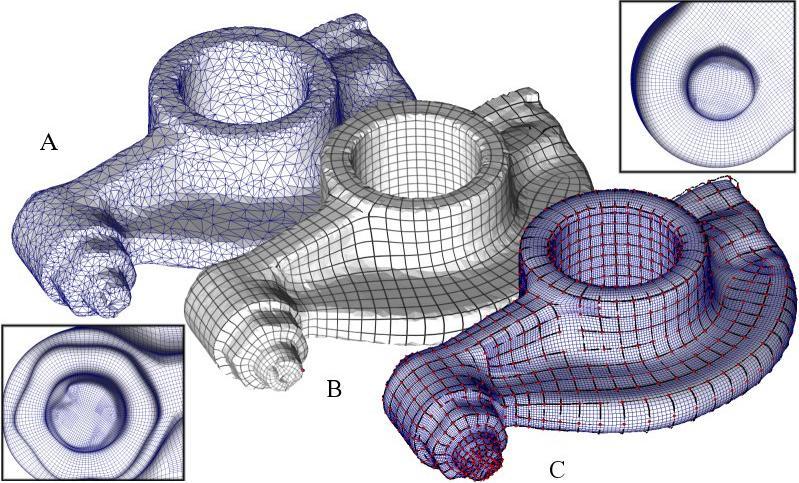Section: Scientific Foundations
Geometry Processing
Participants : Laurent Alonso, Alejandro Galindo, Phuong Ho, Samuel Hornus, Thomas Jost, Bruno Lévy, David Lopez, Kun Liu, Romain Merland, Vincent Nivoliers, Jeanne Pellerin, Nicolas Ray, Dmitry Sokolov, Rhaleb Zayer.
|
Geometry processing recently emerged (in the middle of the 90's) as a promising strategy to solve the geometric modeling problems encountered when manipulating meshes composed of hundred millions of elements. Since a mesh may be considered to be a sampling of a surface - in other words a signal - the digital signal processing formalism was a natural theoretic background for this subdomain (see e.g., [32] ). Researchers of this domain then studied different aspects of this formalism applied to geometric modeling.
Although many advances have been made in the geometry processing area, important problems still remain open. Even if shape acquisition and filtering is much easier than 30 years ago, a scanned mesh composed of hundred million triangles cannot be used directly in real-time visualization or complex numerical simulation. For this reason, automatic methods to convert those large meshes into higher level representations are necessary. However, these automatic methods do not exist yet. For instance, the pioneer Henri Gouraud often mentions in his talks that the data acquisition problem is still open. Malcolm Sabin, another pioneer of the “Computer Aided Geometric Design” and “Subdivision” approaches, mentioned during several conferences of the domain that constructing the optimum control-mesh of a subdivision surface so as to approximate a given surface is still an open problem. More generally, converting a mesh model into a higher level representation, consisting of a set of equations, is a difficult problem for which no satisfying solutions have been proposed. This is one of the long-term goals of international initiatives, such as the AIMShape European network of excellence.
Motivated by gridding application for finite elements modeling for oil and gas exploration, in the frame of the Gocad project, we started studying geometry processing in the late 90's and contributed to this area at the early stages of its development. We developed the LSCM method (Least Squares Conformal Maps) in cooperation with Alias Wavefront [7] . This method has become the de-facto standard in automatic unwrapping, and was adopted by several 3D modeling packages (including Maya and Blender). We experimented various applications of the method, including normal mapping, mesh completion and light simulation [2] .
However, classical mesh parameterization requires to partition the considered object into a set of topological disks. For this reason, we designed a new method (Periodic Global Parameterization) that generates a continuous set of coordinates over the object [8] . We also showed the applicability of this method, by proposing the first algorithm that converts a scanned mesh into a Spline surface automatically [4] . Both algorithms are demonstrated in Figure 2 .
We are still not fully satisfied with these results, since the method remains quite complicated. We think that a deeper understanding of the underlying theory is likely to lead to both efficient and simple methods. For this reason, we studied last year several ways of discretizing partial differential equations on meshes, including Finite Element Modeling and Discrete Exterior Calculus. This year, we also explored Spectral Geometry Processing and Sampling Theory (more on this below).



